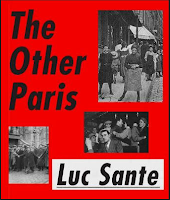 During the snowstorm, I sat down to read Luc Sante's The Other Paris (2015) and couldn't put it down. What an amazing book. Sante starts off by saying that "we have forgotten what a city was" because business and government elites have sanitized the city:
During the snowstorm, I sat down to read Luc Sante's The Other Paris (2015) and couldn't put it down. What an amazing book. Sante starts off by saying that "we have forgotten what a city was" because business and government elites have sanitized the city:The exigencies of money and the proclivities of bureaucrats -- as terrified of anomalies as of germs, chaos, dissipation, laughter, unanswerable questions -- have conspired to create the conditions for stasis, to sanitize the city to the point where there will be no surprises, no hazards, no spontaneous outbreaks, no weeds. (pp. 7-8)Of course, in DC, we have more than our fair share of such newly redeveloped, sanitized places.
Sante then dives into a fascinating world of the other Paris. This isn't the world of the Eiffel Tower, the grand boulevards, or the upper-class residential areas. The other Paris is a world inhabited by shady bars, tiny streets, the "Zone" at the edge of the city, drunks, revolutionaries, and workers of infinite variety, such as prostitutes, criminals, singers, and pliers of strange occupations like zesteuses. This other Paris flourished before 1940 or, at the latest, before 1970. He takes the reader deep into these worlds of the past as a kind of flaneur, strolling through and exploring the city. The images in the book are particularly amazing.
 Sante talks about how flaneurs explore the ghostly or dreamlike presences of "composted layers of a thousand eras, and any given moment includes some proportionate blend of all those eras" (p. 31). This made me immediately think of Edward P. Jones' dreamlike collection of short stories Lost in the City about the African American neighborhoods in DC destroyed in the 1960s and 1970s. Jones' characters roam through the city, observing African American social worlds and their boundaries with white worlds. For Sante, dreams and folklore are often the only ways to access these worlds, especially in a city in which so many parts of have been erased.
Sante talks about how flaneurs explore the ghostly or dreamlike presences of "composted layers of a thousand eras, and any given moment includes some proportionate blend of all those eras" (p. 31). This made me immediately think of Edward P. Jones' dreamlike collection of short stories Lost in the City about the African American neighborhoods in DC destroyed in the 1960s and 1970s. Jones' characters roam through the city, observing African American social worlds and their boundaries with white worlds. For Sante, dreams and folklore are often the only ways to access these worlds, especially in a city in which so many parts of have been erased.Sante despairs about the clean up of Paris. Money, power, and desire for security have destroyed the other Paris. Thus, his book is a reminder about "what life was like in cities when they were vivid and savage and uncontrollable as they were for many centuries" (p. 17). I was particularly struck by the value of neglect and decay for cities. In the 1960s, 1970s, and maybe early 1980s, downtown DC had been redlined (redlining is "arbitrarily denying or limiting financial services to specific neighborhoods, generally because its residents are people of color or are poor"). In this area neglected by banks and investment, people could try out a lot of new ideas very cheaply and the people in the area were relatively open to such experiments. The place flourished with punk shows, cooperatives, etc. And this was a place where low-income people of all sorts could live and have a place in the city. Sante reminds us that, in our current situation, the cleaning up of cities eradicates these worlds.
He rightly condemns the urban renewal of the 1960s and 1970s, which destroyed and redeveloped large areas of cities around the world. Today's redevelopment of cities continues this destruction, as we see along the Waterfront. Yet, some of the products of urban renewal, such as public housing, the War on Poverty funding, and the general neglect of cities allowed for the non-sanitized lifeblood of the city to be rejuvenated.
One could say that things are always changing in cities, but the sanitizing of cities in the 19th century and today has destroyed what makes cities great: "The small has been consumed by the big, the poor have been evicted by the rich, the drifters are behind glass in museums. Everything that was once directly lived has moved away into representation" (p. 271). Sante concludes:
The history of Paris teaches us that beauty is a by-product of danger, that liberty is at best a consequence of neglect, that wisdom is entwined with decay. Any Paris of the future that is neither a frozen artifact nor an inhabited holding company will perforce involve fear, dirt, sloth, ruin, and accident. It will entail the continual experience of uncertainty, because the only certainty is death. (p. 271)Maybe we should go in search of what makes DC a great city in the dirt, decay, and neglect?
P.S. And we could look at the deadzones?